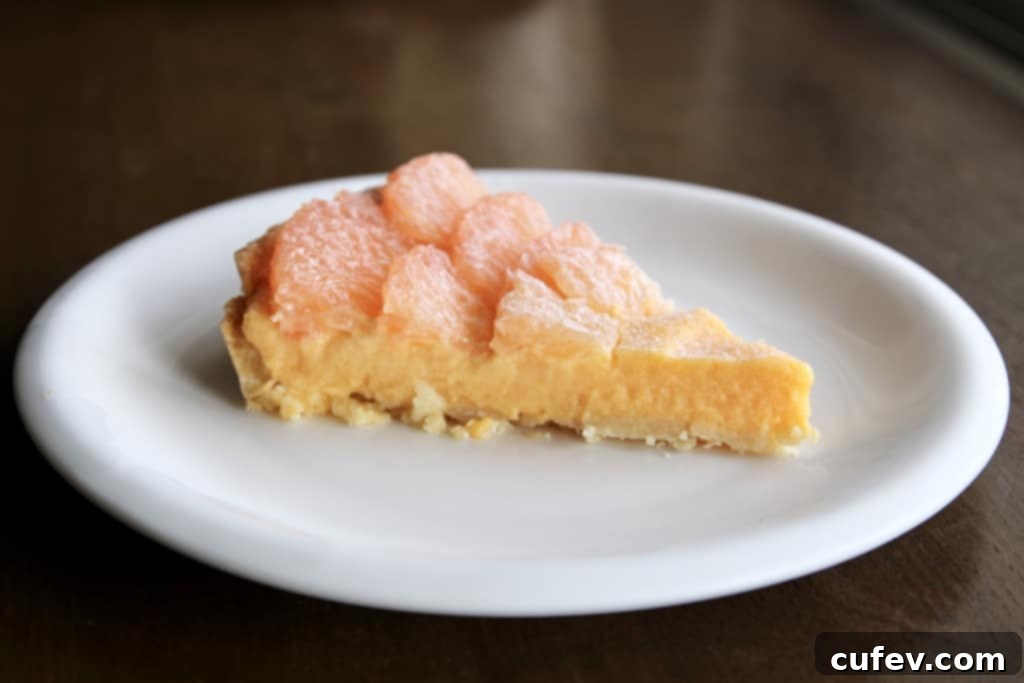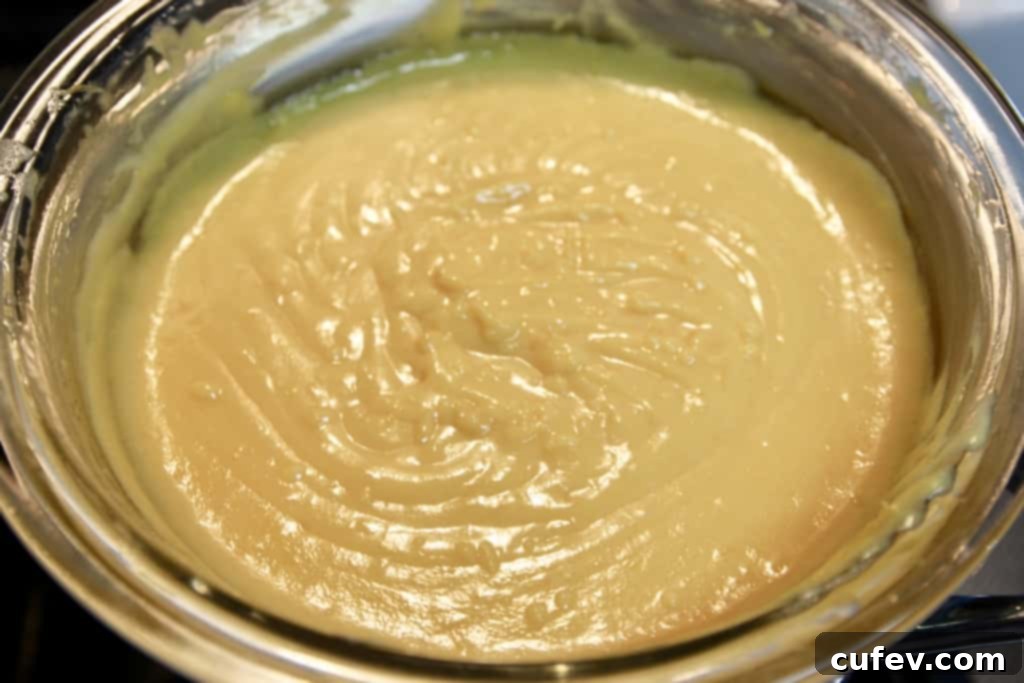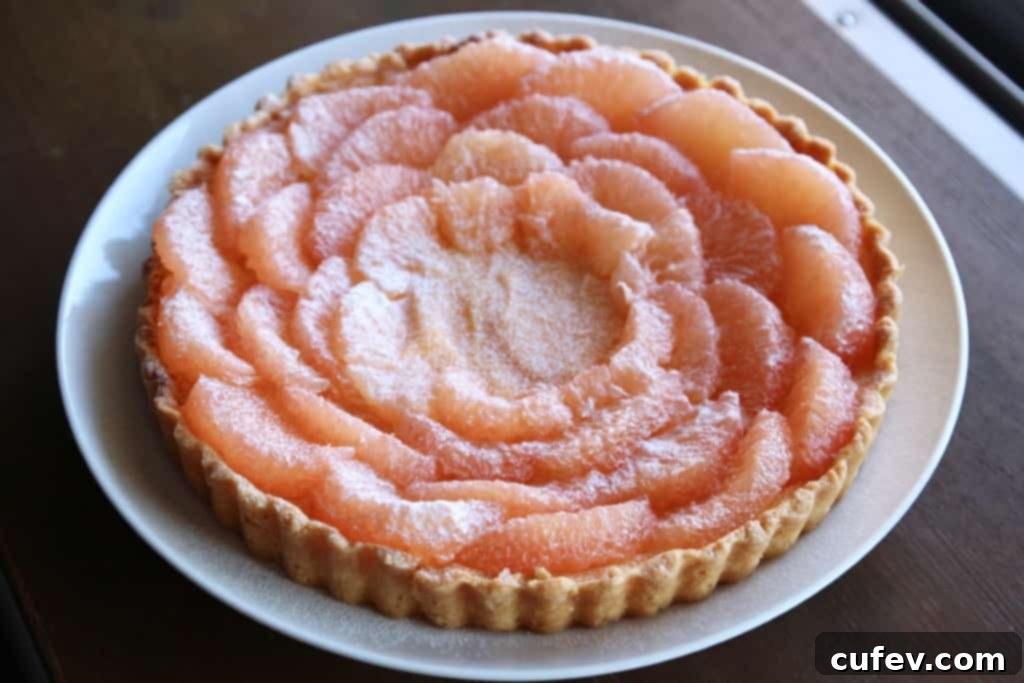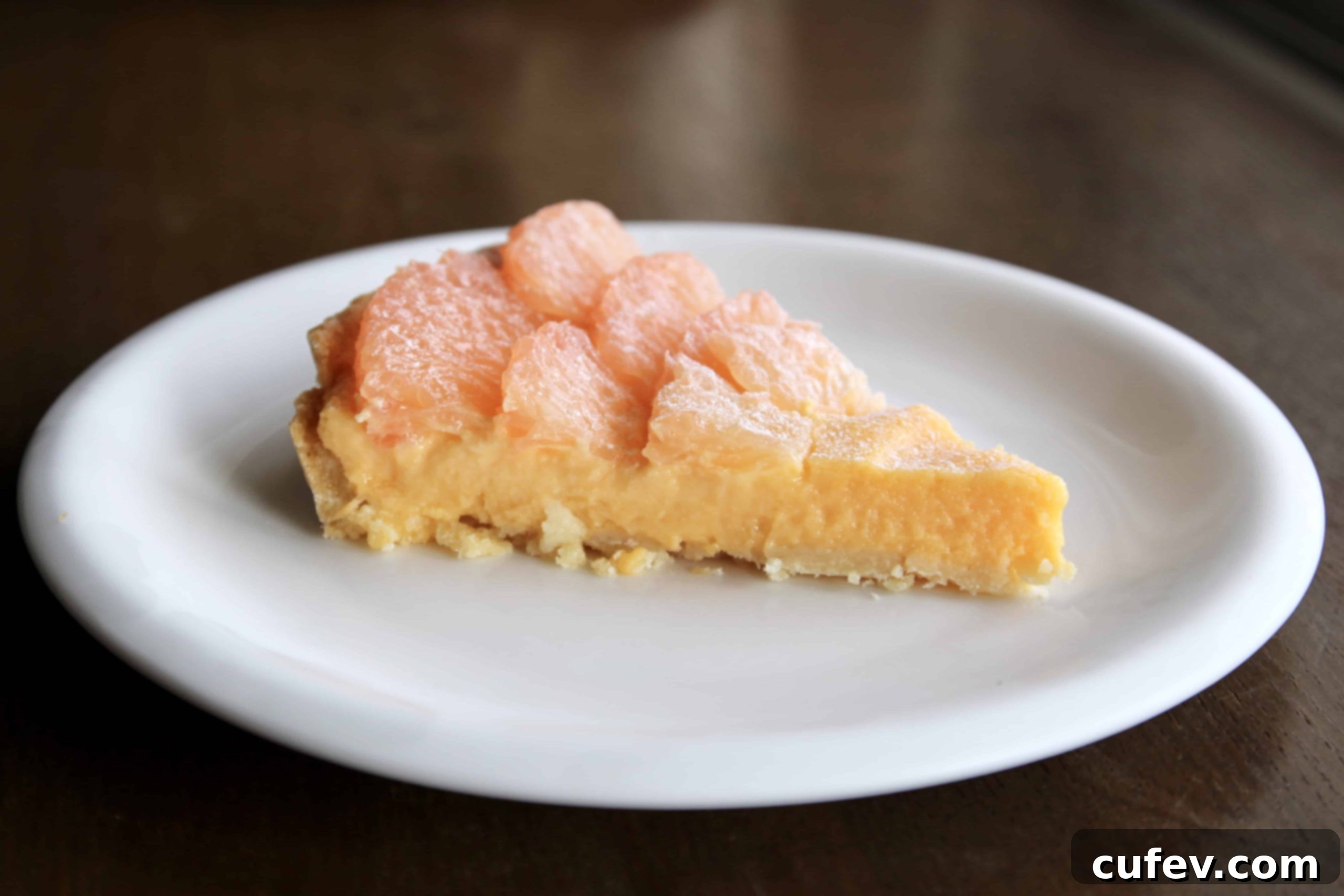Refreshing Homemade Grapefruit Curd Tart: A Sweet & Tangy Dessert Recipe

There was a time, not long ago, when the mere thought of grapefruit would send a shiver down my spine. Its pronounced bitterness always overshadowed any potential sweetness, making it a fruit I actively avoided in favor of its sweeter, more approachable citrus cousins, like oranges. Why choose a grapefruit when a sweet and tangy orange offered such immediate gratification? However, as my summer honeymoon approached, a new motivation emerged. The desire to embrace a healthier lifestyle, coupled with the popular notion that grapefruit can give your metabolism a gentle nudge, prompted me to revisit this intriguing, often misunderstood fruit.
To my genuine surprise, my first encounter with grapefruit in years was a revelation. The initial bitterness was still present, but it was beautifully balanced by an underlying sweetness and a vibrant acidity that was incredibly refreshing. This newfound appreciation for grapefruit sparked a culinary inspiration: what better way to celebrate this conquered aversion than by transforming it into a luxurious dessert? And thus, the idea for this Grapefruit Curd Tart was born. As expected, I’m now just as enamored with this delightful tart as I am with the fruit itself. The moment I took my first bite, I knew I had created something special. The crust, a golden-brown testament to buttery perfection, provided a satisfying crunch. The grapefruit curd, silken and creamy, delivered a harmonious blend of sweet, tangy, and subtly bitter notes that sang on the palate. And the fresh grapefruit segments, glistening like jewels, added a light, juicy burst that kept the tart from feeling too heavy, elevating it to an incredibly refreshing dessert experience. My partner, Tristan, even declared it his favorite tart I’ve ever made for him – high praise indeed!
Embracing the Zest: A Culinary Journey with Grapefruit
My journey with grapefruit has been an interesting one, a testament to how our tastes can evolve and surprise us. For years, grapefruit represented a culinary roadblock, an acquired taste I had no intention of acquiring. Yet, the pursuit of wellness, often intertwined with simple dietary adjustments, led me back to its unique charms. What I discovered wasn’t just a fruit with purported health benefits, but a complex flavor profile that, when properly harnessed, can be truly extraordinary. The tartness and bitterness that once deterred me are precisely what make grapefruit such a fascinating ingredient in baking, providing a sophisticated counterpoint to sweetness that other citrus fruits might lack. This elegant balance is what makes a grapefruit curd so compelling, standing out amongst its lemon and lime counterparts.
This Grapefruit Curd Tart is more than just a dessert; it’s a celebration of discovery and a testament to the versatility of this remarkable fruit. It showcases how a humble ingredient, once overlooked, can be transformed into a showstopping confection that delights the senses. Each component of this tart plays a crucial role in creating a balanced and unforgettable experience, from the crisp, buttery crust to the velvety curd and the fresh, vibrant fruit segments. It’s a perfect example of how a simple fruit can elevate a classic dessert to something truly special, offering a refreshing twist on traditional flavors.

Starting with the Foundation: The Perfect Buttery Tart Crust
Every great tart begins with an exceptional crust, and this grapefruit curd tart is no exception. A perfectly baked crust provides the essential structure and a delightful textural contrast to the smooth, creamy filling. For this recipe, I turned to David Lebovitz’s renowned French tart dough recipe, a reliable choice known for its rich, buttery flavor and wonderfully crumbly, yet sturdy, texture. This particular recipe ensures a crust that can hold up to the luscious curd without becoming soggy, providing that satisfying bite with every forkful. While his recipe suggested a baking time of approximately 15 minutes for blind baking, I found that my oven required a little longer to achieve that beautiful golden-brown hue and crispness that signifies a perfectly blind-baked crust. This slight variation in baking time is a common occurrence in baking, underscoring the importance of knowing your oven and baking until the crust looks and feels right, rather than adhering rigidly to a timer.
Achieving a flawless tart crust might seem daunting, but with a few simple techniques, you can ensure a professional-quality base for your grapefruit curd. The goal is a crust that is both flaky and sturdy, able to support the creamy filling without crumbling, yet delicate enough to melt in your mouth. This balance is key to a truly successful tart, and it all starts with the proper preparation of the dough and careful blind baking.
Tips for a Flawless Tart Crust:
- Blind Baking is Key: This process of baking the crust without the filling is absolutely crucial for preventing a soggy bottom once the wet curd is added. To blind bake, line your chilled pastry shell with parchment paper and fill it completely with pie weights, dried beans, or rice. This helps to weigh down the dough, preventing the sides from slumping and the bottom from puffing up unevenly during baking.
- Chill, Chill, Chill: Don’t underestimate the power of refrigeration! Chilling the dough thoroughly before rolling and again before baking is crucial. It helps the butter solidify, preventing the crust from shrinking excessively in the oven and ensuring a delightfully flaky texture. Cold butter equals a flakier crust.
- Prick the Bottom: Before blind baking and after chilling, gently prick the bottom of the crust all over with a fork. These small holes allow steam to escape from underneath the dough, preventing large air bubbles from forming and creating an uneven surface, which could lead to cracks in your curd.
- Check for Doneness: A well-baked crust is essential. The crust should be evenly golden brown, not just lightly colored, both on the bottom and along the sides. A perfectly baked crust will be sturdy enough to hold the curd without becoming soft or collapsing when sliced. If the edges are browning too quickly during baking, you can lightly cover them with strips of aluminum foil to protect them during the last few minutes.
- Cool Completely: Just like the curd, the tart crust must be cooled completely to room temperature before you add any filling. Pouring warm curd into a warm crust can lead to condensation and a less crisp result.

Crafting the Silken Smooth Grapefruit Curd: The Heart of the Tart
While your tart crust is transforming into a golden masterpiece in the oven, it’s the perfect time to turn your attention to the star of the show: the grapefruit curd. Citrus curds are a favorite of mine, offering a delightful balance of sweet and tangy flavors that can brighten any dessert. I’ve previously dabbled in creations like yuzu cheesecake (which features a vibrant yuzu curd) and even a surprisingly delicious carrot curd! My preferred method for making smaller batches of curd has always been a double boiler. This gentle heating technique slowly cooks the eggs, preventing them from scrambling and ensuring a perfectly smooth, lump-free consistency. It’s a foolproof way to achieve that luscious, velvety texture without worrying about overcooking the delicate egg proteins.
However, when making a larger quantity of curd, as required for a generous 9-inch tart, the double boiler method can become quite time-consuming. The larger volume of liquid takes much longer to heat and thicken over indirect heat. In such cases, I’ve found that using a regular saucepan directly over medium-low heat is perfectly acceptable, provided you remain vigilant and committed to the process. The key to success here is constant whisking. Seriously, do not step away from the pan! Continuous whisking prevents the eggs from setting too quickly at the bottom and sides, ensuring an even, creamy texture throughout. You’ll know the curd is ready when it thickens to the consistency of mayonnaise, coating the back of a spoon, and holding a clear trail when you run your finger across it. If you have a thermometer, aim for approximately 175°F (79°C), ensuring the eggs are cooked without curdling.
Key Steps for Perfect Grapefruit Curd:
- Fresh Ingredients are Paramount: Always, and I mean always, use freshly squeezed grapefruit juice and freshly zested grapefruit. The flavor difference is immense compared to bottled juice. The zest carries the essential oils that provide a concentrated citrus aroma and flavor that cannot be replicated. Choose bright, firm grapefruits for the best results.
- Combine Wet Ingredients First: In a medium saucepan (if using direct heat) or a heatproof bowl (if using a double boiler), whisk together the softened unsalted butter, granulated sugar, and fine sea salt until combined. Then, gradually beat in the whole eggs one at a time, followed by the egg yolks, ensuring each addition is fully incorporated before adding the next. Finally, stir in the fresh grapefruit juice and vibrant grapefruit zest. This gradual incorporation helps create a smooth, homogenous mixture.
- Gentle Heat, Constant Whisking: Place the saucepan over medium-low heat (or the bowl over a pot of simmering water for the double boiler method). The magic happens here: cook, whisking constantly and diligently scraping the bottom and sides of the pan. This continuous motion is critical to prevent the eggs from scrambling and to ensure even thickening. The curd will gradually thicken to the consistency of mayonnaise or a pourable custard, usually taking about 10-15 minutes on direct heat, or slightly longer with a double boiler. Do not let it boil vigorously, as this can cause the eggs to curdle.
- Strain for Impeccable Smoothness: Once thickened to perfection, immediately remove the curd from the heat. Pour the grapefruit curd through a fine-mesh sieve into a clean bowl. This crucial step removes any tiny bits of cooked egg (should any have formed despite your whisking efforts) and also separates out the grapefruit zest, resulting in an impeccably smooth and velvety curd that’s pure luxuriousness.
- Prevent Skin Formation: To prevent an undesirable “skin” from forming on the surface as it cools, press a piece of plastic wrap directly onto the surface of the warm curd. This creates an airtight seal, keeping it perfectly smooth and glossy.
- Cool Completely: Allow the curd to cool completely to room temperature before pouring it into your tart shell. This ensures that the curd sets correctly, maintains its smooth texture, and doesn’t compromise the crispness of your beautifully baked crust.

Assembly and the Indispensable Chilling Process
With both the buttery tart crust and the vibrant grapefruit curd cooled to room temperature, the assembly process is wonderfully straightforward and immensely satisfying. Carefully pour the smooth, fragrant grapefruit curd into the blind-baked tart shell, ensuring it spreads evenly to fill every crevice. The contrast in textures and temperatures at this stage is already promising: a crisp, sturdy shell awaiting its creamy, luscious filling. This is where your careful preparation pays off, as the curd should flow smoothly and beautifully into the shell.
Once the curd is neatly nestled in its golden bed, the entire tart needs a period of rest in the refrigerator. This chilling step is absolutely vital for several reasons, and it’s not one to rush. Typically, an hour or two in the fridge is sufficient for the curd to fully set. During this time, the fats in the butter within the curd will firm up, transforming the liquid mixture into a stable, sliceable, and utterly delectable filling. Without adequate chilling, the tart would be too soft and messy to cut cleanly, and the flavors wouldn’t have the chance to meld and deepen properly. This patient waiting period ensures that each slice you serve will be perfectly formed, showcasing the beautiful layers of crust and curd, ready to be adorned with fresh grapefruit segments.

The Art of Segmenting Grapefruits: A Garnish with Purpose
While your tart is chilling to perfection, take this opportune moment to prepare the crowning glory: fresh grapefruit segments. This step not only adds a burst of vibrant color and an extra layer of refreshing juiciness but also enhances the overall eating experience by eliminating the tough, often bitter, membranes. For this particular tart, I initially miscalculated, believing I had an 8-inch tart pan when it was, in fact, a 9-inch one. This led to using only three grapefruits, resulting in a slightly empty patch in the center. However, rather than seeing it as a flaw, it became an opportunity for creative presentation, easily remedied by a delicate dusting of powdered sugar. The aesthetic appeal of neatly segmented citrus really elevates the tart from delicious to truly gourmet.
How to Segment a Grapefruit (or any Citrus) for the Perfect Tart Topping:
- Top and Tail: Using a sharp chef’s knife, carefully slice off both ends of the grapefruit, just enough to expose the juicy pink or yellow flesh. This creates a stable base for the next step and helps you see the segments.
- Remove the Peel and Pith: Place the grapefruit on one of its flat ends on your cutting board. Carefully slice downwards, following the natural curve of the fruit, to remove the peel and all of the bitter white pith. Ensure no white pith remains, as even small bits can detract from the flavor and texture. Rotate the fruit as you go until all the peel and pith are completely removed, leaving a naked orb of citrus flesh.
- Segment the Flesh: Hold the peeled grapefruit in one hand over a bowl (to catch any precious juice). Carefully slice inwards along one side of a membrane to release a segment. Then, slice along the other side of the same membrane to free the segment completely. Repeat this process for all the segments, allowing them to fall into the bowl. Any remaining juice in the core can be squeezed out and saved for another use (or enjoyed immediately!).
- Arrange and Garnish: Once your tart is thoroughly chilled and the curd is firmly set, it’s time to artfully arrange the grapefruit segments on top. You can create a symmetrical pattern, an overlapping spiral, a rustic scattered look, or any design that appeals to your aesthetic sense. To enhance the presentation and, as I discovered, to cleverly conceal any minor imperfections (like an unintended empty patch or less-than-perfect segmenting skills), a light dusting of powdered sugar is a fantastic finishing touch. It adds a delicate sweetness, a beautiful visual contrast, and an ethereal appearance that makes the tart truly inviting.

The Irresistible Flavor and Texture Profile: A Culinary Triumph
The moment of truth arrives when you finally slice into this magnificent Grapefruit Curd Tart. The experience is nothing short of delightful, a symphony of textures and flavors that dance on the palate, confirming that every step of preparation was worthwhile. The buttery crust, with its satisfying crunch and rich flavor, provides a perfect counterpoint to the velvety smooth grapefruit curd. This curd is a marvel in itself – perfectly sweet to balance the inherent tang and subtle bitterness of the grapefruit, yet allowing the fruit’s distinctive, bright character to shine through. It’s a flavor profile that is both familiar and exciting, comforting yet sophisticated, appealing to both citrus enthusiasts and those newly converted.
What truly sets this tart apart is its incredibly light and refreshing quality. Unlike many tarts and pies that can feel overly rich and heavy after just a few bites, this grapefruit creation offers a crisp, clean finish that leaves you wanting more, not feeling weighed down. The fresh grapefruit segments, arranged atop the curd, significantly contribute to this lightness with their juicy bursts of flavor, cutting through any potential richness and making each mouthful invigorating. This refreshing nature makes it incredibly challenging to stop at just one slice! It’s an ideal dessert for warm weather gatherings, a vibrant centerpiece for brunch, or a sophisticated finish to any meal, providing a memorable culinary experience that is both elegant and approachable.
This tart is a testament to the fact that sometimes, the most surprising ingredients can yield the most exquisite results. My initial dislike for grapefruit has evolved into a deep appreciation, all thanks to this recipe. It’s a reminder that culinary exploration often leads to wonderful discoveries, transforming preconceived notions into delightful realities. I wholeheartedly encourage you to try this recipe, even if you, like my former self, harbor reservations about grapefruit. You might just find your new favorite dessert, and perhaps, a newfound love for this extraordinary citrus fruit!
A Trip Down Memory Lane: One year ago, I was sharing the recipe for an equally delightful Strawberry & Blueberry Tart with a Corn Cookie Crust – another wonderful creation perfect for fruit lovers and a testament to the versatility of fruit in baking!

Grapefruit Curd Tart
Print
Pin
Rate
Ingredients
- 9-inch tart crust
- ¾ cup grapefruit juice
- 1 tablespoon grapefruit zest
- ½ cup + 1 tablespoon unsalted butter
- 3 whole eggs
- 6 egg yolks
- ¾ cup granulated sugar
- ¼ teaspoon fine sea salt
- 4 grapefruits
Instructions
-
Blind bake the tart crust until golden brown and set aside to cool completely. Refer to instructions for your chosen tart crust recipe (e.g., David Lebovitz’s French Tart Dough) for precise baking times and temperatures, ensuring it is fully cooked and crisp.
-
In a medium saucepan (or a heatproof bowl set over a double boiler for a gentler method), combine the softened unsalted butter, granulated sugar, and fine sea salt. Whisk until the sugar begins to dissolve and the mixture is well combined.
-
Gradually whisk in the whole eggs one at a time, followed by the egg yolks, ensuring each addition is fully incorporated before adding the next. This prevents the eggs from clumping. Stir in the fresh grapefruit juice and vibrant grapefruit zest. Continue to mix until the mixture is smooth and homogenous.
-
Place the saucepan over medium-low heat (or continue to heat over the double boiler). Cook, whisking constantly and diligently scraping the bottom and sides of the pan, until the mixture thickens to the consistency of mayonnaise and coats the back of a spoon. It should reach about 175°F (79°C) if you’re using a thermometer. Do not let it boil vigorously, as this can cause the eggs to curdle. This usually takes 10-15 minutes on direct heat.
-
Immediately remove the curd from the heat. Pour the grapefruit curd through a fine-mesh sieve into a clean bowl to remove any tiny cooked egg bits and the zest, ensuring a perfectly smooth and velvety curd.
-
Cover the surface of the curd directly with plastic wrap (ensure the wrap touches the curd’s surface). This creates an airtight seal and prevents a “skin” from forming as it cools. Allow it to cool completely to room temperature before proceeding.
-
Once both the tart crust and the grapefruit curd are fully cooled, pour the curd evenly into the cooled tart shell. Chill the entire tart in the fridge for a minimum of 1 to 2 hours, or until the curd is firmly set and cold to the touch.
-
While the tart is chilling, prepare your grapefruit segments. Using a sharp knife, slice off the top and bottom of each grapefruit. Then, carefully cut away the peel and white pith from the sides. Over a bowl, slice along the membranes to release individual grapefruit segments, discarding the membranes.
-
Once the tart is thoroughly chilled and set, decoratively arrange the fresh grapefruit segments over the curd. For an elegant finish and to subtly mask any imperfections, you may lightly dust the tart with powdered sugar before serving. Slice and enjoy this refreshing dessert!
